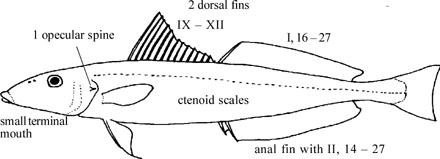SILLAGINIDAE
Sillago (smelt, whitings)
By Ukkrit Satapoomin
 Sillago aeolus |
 Sillago intermedius |
 Sillago sihama |
|
Moderate-sized (to 50 cm), elongate fishes. Opercle with a small sharp spine; lower part of preopercle horizontal. Snout long and conical. Mouth small, terminal; end of upper jaw sliding below preorbital bone. Teeth villiform, in broad bands; small teeth on roof of mouth restricted to anterior part of vomer, none on palatines. Two separate dorsal fins, the first with IX - XII slender spines; the second with I spine and 16 - 27 soft rays; anal fin long, with II weak spines and 14 - 27 soft ray. Scales small, ctenoid; lateral line slightly arched. Swimbladder frequently complex. Color: silvery to sandy gray or green, sometimes with black spots on body and pectoral fin base.
Similar families occurring in the area. Branchiostegidae: a single continuous dorsal fin; mouth large with fleshy lips. Pinguipedidae (= Parapercidae, Mugiloididae): dorsal fin spines short; spinous dorsal fin sometimes joined to soft dorsal fin; pelvic fin base in advance of pectoral fin base. Remarks. Silliganids are inshore, bottom-dwelling, schooling fishes with a few species found in deeper water to about 180 m. They frequently enter estuaries, penetrating into fresh water for brief periods. They feed mainly on benthic or epibenthic organisms. The family name derived from Greek, syllego = to meet, to make meeting. |

|
|